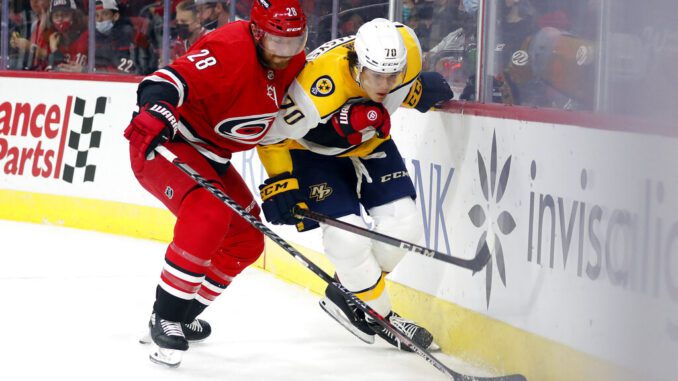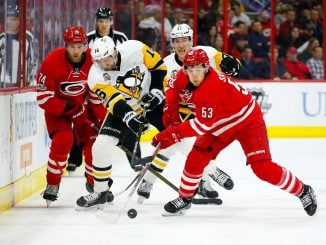
RALEIGH — Ahead 2-1 in the third period on Dec. 11 in Edmonton, the Carolina Hurricanes did something you never want to do: give the Oilers’ power play a chance.
The Hurricanes went down a man when defenseman Brady Skjei was called for a penalty six minutes into the final period, allowing the hometown Oilers — and their top-ranked power play with a 32.5% conversion rate — the opportunity to tie the game.
A blocked shot, save and clear ran down the first half of the power play. Another Frederik Andersen save, a shorthanded rush for Carolina and two more clears ended the threat.
Then Skjei — who is third on the team in shorthanded ice time this season — took another penalty with just over nine minutes remaining.
Back to work, and this time there was some luck involved. The Oilers had Grade-A two chances, including one for Connor McDavid alone in the slot, that went wide.
The Hurricanes again survived and went on to a 3-1 win.
It was the second game of a streak that has now reached nine games in which Carolina has not allowed a power play goal. The Hurricanes have killed off 30 straight power plays since allowing a goal on Dec. 7 in Winnipeg.
“We expect to kill a penalty … It’s a crucial part of the game,” Hurricanes coach Rod Brind’Amour said following Friday’s home win over Calgary when the streak hit a month.
The success is not new for the Hurricanes under Brind’Amour. In his first three full seasons behind the Carolina bench, Brind’Amour has seen his team rank ninth, second and third on the penalty kill. This year it is ranked second again, having allowed just 11 goals while shorthanded for a 91.7% success rate. That ranks behind only Pittsburgh’s 92.8%.
Since Brind’Amour took over in 2018, the Hurricanes have had the best cumulative penalty kill at 87.9% through Monday’s games. Boston and Tampa Bay are tied for second at 86.1%.
So what makes a good penalty kill? Like the two kills against the Oilers, it’s effort, structure, opportunity and often luck.
“I think you do need to outwork the other guys,” defenseman Ian Cole said Monday, “but you’re also outnumbered, so just running around like chickens with their heads cut off doesn’t really do it because you’re obviously down a man.
“So I think it has to be a mix of smart reads, good anticipation, and, yes, then outworking too.”
Cole has been known throughout his career as a reliable penalty killer, logging more than 1,100 minutes shorthanded in 626 career regular season games with St. Louis, Pittsburgh, Columbus, Colorado, Minnesota and Carolina. He found out early he would need to play shorthanded if he wanted to stick around the league.
“When I got to St. Louis and I had Ken Hitchcock (as coach), he basically said, ‘Yeah, you’re not gonna be touching the ice on the power play anymore, which I used to run in college,” Cole said. “I used to be a skilled defenseman, at least a little bit skilled. And he basically said, ‘Yeah, you’re not going to be playing unless you do X, Y and Z.’ So I had to adapt pretty quickly.”
Assistant coach Tim Gleason was, like Cole, a defensive defenseman who spent a lot of time on the kill. Now running the penalty kill this season after he replaced Dean Chynoweth on Brind’Amour’s staff, Gleason said the key to a successful unit is everyone being on board with the plan.
“You can have any type of system, but if guys aren’t buying into it, it doesn’t matter what it is,” Gleason said.
The Hurricanes have buy-in from players up and down their roster, including top-of-the-lineup players like Sebastian Aho and Teuvo Teravainen who also offer the threat of shorthanded scoring chances — as they had in Edmonton — on top of being adept penalty killers.
“I think that’s changed in the last two, three years,” Gleason said of skill players logging more minutes on the penalty kill. “It’s interesting because we always talk about like, ‘Hey, when you can go, go.’ If we can score a shorthanded goal, obviously, we want to do that.
“But at the same time, buying in is doing the right things at the right times in our zone and on the forecheck, and we stick to our system,” Gleason continued. “And it doesn’t matter if you’re a 25-goal scorer or five-goal scorer — if you’re buying into it and you do the right things with discipline, I think it kind of shows how it works out.”
While most of the league’s penalty kills look the same — a standard four-man box with varying levels of aggressiveness depending on the team and players on the ice — there are always tweaks being made, whether it’s because of the next opponent or things that didn’t work in a previous game.
“It’s what the other team is bringing, right?” Gleason said. “Or what maybe lit us up the night before. Like if we weren’t very good in situations or from a forecheck standpoint, it’s not necessarily that particular thing that we would change. … I think it’s a game-by-game basis, you have to adapt a little bit.”
For now, everything is going right for the Hurricanes’ penalty kill.
“For the past month we’ve been fortunate,” Cole said, “but those tides can change quickly if you’re not careful.”



